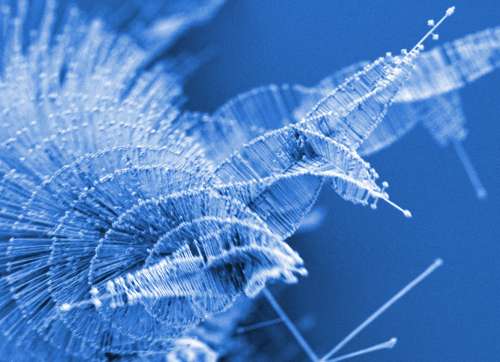
Frost, icicles and snowflakes are all too familiar to the people of Wisconsin, especially on winter mornings. But the icy-looking structures in the image above, created by scientists at the University of Wisconsin–Madison, US, didn’t form in the cold — they are nanowire “pine trees” grown via chemical vapour deposition (CVD) of lead sulfide at temperatures verging on 650 °C.
CVD is often used to grow nanowires, but it usually requires a catalytic nanoparticle “seed” to get the structure started. Song Jin and colleagues have found that by modifying the flow of hydrogen gas used in CVD the nanowires do not need a catalytic seed. Instead, the growth of their nanowires can be driven by a type of defect known as a screw dislocation, which creates a spiral step for atoms to settle on. When the researchers follow-up the CVD with another deposition technique, known as vapour-liquid-solid growth, horizontal nanowires grow outwards from the steps to form tree-like structures (Science doi: 10.1126/science.1157131).
Although Jin’s team have created branched nanowires before, this is the first time they have created structures with such intricacy. In fact, they think their nanowire pine trees are so intricate they might be the best evidence yet for a theory of dislocations called the Eshelby twist. This theory, put forward by 55 years ago by materials scientist John Eshelby, then at the University of Illinois at Urbana, proposes that the stress created by a dislocation generates a torque at either end of the cylinder, forcing it to twist.
Eshelby twists have been observed in nature before, but the horizontal branches in nanowire pine trees could serve as markers to highlight the extent of it. Jin’s team think Eshelby’s theory will help them to understand the layout of the branches of their nanowire pine trees, in doing so providing the “clearest demonstration” of the theory’s validity. “Lying beneath these beautiful nanostructures is a beautiful and fundamental science that goes back to the heart of crystal growth theory,” says Jin.



